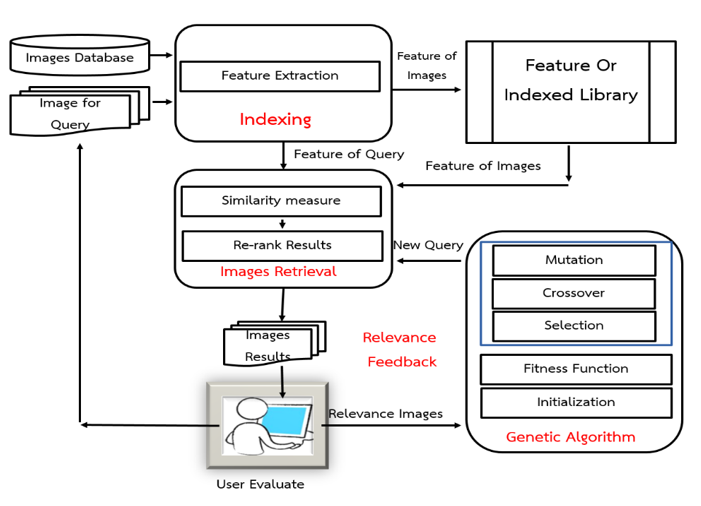ENHANCEMENT OF QUERY WITH RELEVANCE FEEDBACK USING GENETIC ALGORITHMS IN COMBINATION WITH NEIGHBORHUTSURT METHODS FOR CONTENT-BASED IMAGES RETRIEVAL.
Main Article Content
Abstract
Currently, the publishing of images on the Internet is growing rapidly. This is a consequence
of the advancement of the tool. and technology. resulting in a large number of published images. To search for the desired image. Requires a highly efficient and capable image retrieval system. The old retrieval format used keywords from metadata. by comparing it with the question. But what if two users want to retrieve the same image? In which each user does not use the same question text. Make the system retrieve images from text. difficult to consider and compare. Improving questions with feedback correlation using genetic algorithms in combination with neighboring hoots art methods. It is a semi-automatic system. User can select the correct result image according to their requirement from past retrieval cycle. and make improvements to a new question image. and feed back into the system As a result, the resulting image is more suitable for the user's needs. The results of the experiment showed that this method by the researchers gave an average F-measure of 0.87. When, which means the system is performing at a good level and yielded higher results than the results of the first round of image retrieval without the reverse correlation feed process. which meets the stated objectives of the research
Article Details

This work is licensed under a Creative Commons Attribution-NonCommercial-NoDerivatives 4.0 International License.
เนื้อหาและข่อมูลในบทความที่ลงตีพิมพ์ในวารสารวิชาการ เทคโนโลยี พลังงาน และสิ่งแวดล้อม บัณฑิตวิทยาลัย วิทยาลัยเทคโนโลยีสยาม ถือเป็นข้อคิดเห็นและความรับผิดชอบของผู้เขียนบทความโดยตรง ซึ่งกองบรรณาธิการวารสารไม่จำเป็นต้องเห็นด้วย หรือว่าร่วมรับผิดชอบใด ๆ
บทความ ข้อมูล เนื้อหา รูปภาพ ฯลฯ ที่ได้รับการตีพิมพ์ในวารสารวิชาการ เทคโนโลยี พลังงาน และสิ่งแวดล้อม บัณฑิตวิทยาลัย วิทยาลัยเทคโนโลยีสยาม ถือเป็นลิขสิทธิ์ของวารสารวิชาการ เทคโนโลยี พลังงาน และสิ่งแวดล้อม บัณฑิตวิทยาลัย วิทยาลัยเทคโนโลยีสยาม หากบุคคล หรือหน่วยงานใดต้องการนำทั้งหมด หรือส่วนหนึ่งส่วนใดไปเผยแพร่ต่อ หรือเพื่อกระทำการใด ๆ จะต้องได้รับอนุญาต เป็นลายลักษณ์อักษรจากวารสารวิชาการ เทคโนโลยี พลังงาน และสิ่งแวดล้อม บัณฑิตวิทยาลัย วิทยาลัยเทคโนโลยีสยาม เท่านั้น
References
เอกสารอ้างอิง
H. Takagi, S.-B. Cho, and T. Noda, “Evaluation of an IGA-based image retrieval system using wavelet coefficients,” in Proc. IEEE Int. Fuzzy Syst. Conf., 1999, vol. 3, pp. 1780.
H. Takagi, “Interactive evolutionary computation: Fusion of the capacities of EC optimization and human evaluation,” Proc. IEEE, vol. 89, no. 9,pp. 1275–1296, Sep. 2001.
M. Arevalillo-Herráez, F. H. Ferri, and S. Moreno-Picot, “Distance-based relevance feedback using a hybrid interactive genetic algorithm for image retrieval,” Appl. Soft Comput., vol. 11, no. 2, pp. 1782–1791, Mar. 2011, DOI: 10.1016/j.asoc.2010.05.022.
Liang B., et al. (2012). “Design of Video Retrieval System Using MPEG-7 Descriptors.” In Proceedings Engineering, (2578–2582).
Huayoung L., et al. (2004). “Content-Based TV Sports Video Retrieval Based on Audio-Visual Features and Text information.” In Web Intelligence, 2004, (481–484).
Marchal J., et al. (2006). “Soccer Video Retrieval using adaptive Time-frequency Method.” In Proceedings of 2006 IEEE International Conference on Acoustics, Speech, and Signal Processing. Toulouse: The Institute of Electrical and Electronics Engineers Signal Processing Society, (509–512).
Wang R., et al. (2001). “Video retrieval and relevance feedback in the context of a post-integration model.” In Proceedings of 4th Workshop on Multimedia Signal Processing. Cannes: The Institute of Electrical and Electronics Engineers, (3 -38).
Haas M., et al. (2005). “Relevance feedback methods in content-based retrieval and video summarization.” In Multimedia and Expo, 2005, Proceedings of IEEE International Conference on Multimedia and Expo, 2005. NJ : The Institute of Electrical and Electronics Engineers.
Munesawang, P., et al. (2005). “Adaptive video indexing and automatic/semi-automatic relevance feedback.” IEEE Transactions on Circuits and Systems for Video Technology. 15 : 1032-1046.
Mironica, I., Ionescu, B. and Vertan, C. (2012). “Hierarchical clustering relevance feedback for content-based image retrieval.” In Content-Based Multimedia Indexing (CBMI), Proceedings of 2012 10th International Workshop on Content-Based Multimedia Indexing. Polytech Annecy, Chambery Annecy : The Institute of Electrical and Electronics Engineers.
Hopfgartner, F., et al. (2007). “Evaluating the implicit feedback models for adaptive video retrieval.” In Multimedia Information Retrieval, Proceedings of the international workshop on Workshop on Multimedia Information Retrieval. Bavaria : Association for Computing Machinery, (323-331)
Moshfeghi, Y. and Jose, J. M. (2013). “An effective implicit relevance feedback technique using affective, physiological and behavioural features.” In Proceedings of 36th International ACM SIGIR Conference on Research and Development in Information Retrieval. Dublin : Association for Computing Machinery, (133-142).
Zhang, H., Kankanhalli, A. and Smoliar, S. W. (1993). “Automatic Partitioning of Full Motion Video.” Multimedia Systems. 1 : 10-28.
Shahraray B. (1995). “Scene change detection and content-based sampling of video sequences.” In Proceedings of Digital Video Compression: Algorithms and Technologies 1995. San Jose : The International Society for Optical Engineering, (2-13).
Hampapur A., et al. (1996). “The Virage image search engine: An open framework for image management.” in Proceedings of Storage and Retrieval for Still Image and Video Databases IV. San Jose : The International Society for Optical Engineering.
Kasturi, R. and Jain R. (1991). “Dynamic Vision." Computer Vision : Principles. Washington : IEEE Computer Society Press.
Yang, X. S. (2008). Nature-Inspried Metaheuristic Algorithms. United Kingdom : Luniver Press.
Pongcharoen, P., et al. (2002). “Determinig optimum genetic algorithm parameters for scheduling the manufacturing and assembly of complex products.” International


